Entries Tagged as 'Theatre'
September 18th, 2010 · No Comments
It’s not often that I dislike a play. I can often look past mediocre writing or questionable acting to see the good side of a show. As someone who worked in community theatre throughout high school, I know how much work goes into a show, so when I go to see a show, I try to appreciate how hard everyone involved worked to put it on. Last night, however, at The Habit of Art I found it hard to appreciate much of anything. I could very easily nitpick about how the entire show was lit almost entirely with florescent lights (which look horrible) or something like that, because technical theatre is my thing, but I’ll stick with bigger themes instead. First of all, the entire premise of the show is the rehearsal of a show, creating a show within a show, which is an effect that can be done tastefully, but isn’t in Habit. It begins with the actors showing up for rehearsal for a (poorly-written) show that most of them hate, which leads to a lot of interruptions of the rehearsal, including a lot of conflict with the “writer” of said poorly-written show about interpretations and such. This really prevented me from getting into either part of the show, because the “outside” play wasn’t present enough to really make a difference, but it was there just enough to be really annoying. Meanwhile, the play within the play (the “inside” play) actually got to be good at bits, but these bits were always interrupted by the “writer,” the “stage manager,” and the “lead actor” yelling at each other. Adding to this was that the whole premise of the “inside” play was very strange. To sum it up in a few sentences, W.H. Auden and Benjamin Britten (a famous poet and a famous pianist/composer, respectively) are both in Oxford towards the end of their lives, having been good friends since they were young men (which is a fine plot of a play, and would be one I could enjoy). At the time the action is happening, however, they’re grumpy, old, sex-craved, homosexual pedophiles. Auden regularly pees in his sink, while Britten plays music with young boys to replace another kind of playing that he’d rather do with them. Auden hires “rent-boys” to give him blowjobs, which it seems was a normal thing for Oxford professors to do at the time, because the rent-boy in the inside play talks of several of his more intellectual “clients.” I’ll stop there, because I’m sure you get the idea. I seem to remember there being more of a plot to the play, but it was overshadowed so much by it making two of England’s greatest intellectuals look really, really bad, that I simply can’t remember anything else. Previously, I have had some experience with the music of Britten, which is beautiful, but have had no experience with Auden. While my opinion of Britten really didn’t change much with this play (mostly because it was clear Britten in the play was trying to restrain himself), I’m not sure that I could ever take Auden seriously now, if I ever got up the nerve to read his poems, which is a shame because he’s one of the best poets the world has ever known. Even though the play is supposedly based on true stories, I feel that the characters were exaggerated under the false idea that this would make them more suitable for the theatre.
I guess I should talk a bit about the venue, because it is one of the reasons such a questionable show was allowed to be put on. Habit is being performed at the National Theatre which, as its name suggests, is publicly funded. Because it doesn’t need to worry about its bottom line, it’s free to host more experimental theatre, which I’m totally all for. If not for places like this, where else could new theatre be tried out? However, the downside to this is that every once in a while, a weird show slips through. It comes with the territory. And as I look at it, you have to see a bad show sometimes to make you truly understand what a good show is.
For the sake of comparison, let’s examine the other two straight plays (in the non-musical sense, not heterosexual sense) we’ve seen and compare and contrast their quality and their venues. Merry Wives of Windsor was a very high-quality play and by far the best performance of Shakespeare that I’ve ever seen. It was put on at the Globe, which is a privately-funded, for-profit theatre. Because of this (and the history of the Globe with Shakespeare, which is definitely the biggest factor) the Globe can’t put on that many “new” plays. The notable exception is Bedlam, the first play written by a woman to be performed at the Globe, the world premiere of which I saw a few weeks ago. It wasn’t a great show, but it’s hard to write a show for the Globe in this day in age. It was quite enjoyable, though it was not nearly the best I’ve seen. Even so, it was clear that it was good enough to make money, which is really all that matters to the theatre in the long run.
The other play we’ve seen is The 39 Steps, a farce of the old Hitchcock film by the same name. It was very good, in my opinion, which isn’t surprising because it is performed at the Criterion Theatre. A West End theatre, and therefore a for-profit theatre, it only shows shows that can make money. The one downside to a theatre like the Criterion, however, is that they only show one show at a time, as opposed to the National, which can be showing 8 in its three theatres at the same time, or the Globe which can have many shows in its repertoire at the same time because of its sparse sets and flexible space.
Looking back, I’ve noticed something interesting about the plays we have seen as a class (and I’m sure that this was intentional), because they were each held in a different kind of venue. Merry Wives was held in the iconic Globe, with its standing room on the ground (The Groundling seats), raised galleries, and wooden stage, while 39 Steps is in a traditional, for-profit, proscenium arch theatre, and Habit of Art is in a huge, publicly-funded theatre complex. I feel that, despite my disappointment with Habit of Art, we’ve had a very well-rounded theatre experience whilst in London, one I hope to supplement with a few more shows before we leave.
Tags: 2010 MatthewM · Theatre
September 14th, 2010 · 1 Comment
While watching 39 Steps, I was particularly struck by the British quality the play. I should first say that I thought that the play was brilliant. It was funny, inviting, featured brilliant directing and acting, and was unlike I had anything I had seen in theatre before.
It was innovative in many ways (at least, to me). The use of intentional mistake, such as the delayed ringing of the telephone, the late entry of the professor, the female hostess having to kick the fireplace to make it roar, etc. endears the viewer to the play, and the cast. With a cast of four, the audience was obviously aware that different characters were played by the same actors – a risky, but in the end, incredibly successful strategy. The talent required and involved in pulling off such a play with only 4 actors made it a hilarious experience, especially when an actor had to play multiple characters in the same scene. Many of the chase scenes, or most of the danger, such as when Hannay is dodging the airplanes, or climbing across bridges, and so on and so forth, always looked silly. The death of the professor, the absurd throwing of the body on to the stage renders a potentially dramatic and tragic scene hilarious. All of the above examples demonstrate the “importance of not being earnest” rule that Fox emphasizes in her text (62). I particularly enjoyed the use of multiple hats, or two sided costumes, which can call into question the legitimacy of character and identity in drama. This risk taking, in my opinion, was really reflective of what Rick was talking about: the greater freedom West-End theatre/directors have, and how it can be used to produce a much more fun play to watch.
The play also featured many staple aspects of British sociological culture, prescribed by Fox in Watching the English. Understatement (see pg. 66) made its most obvious appearance right before intermission: Hannay is shot in the chest, the audience thinks him dead, and his only response: “Booga.” As previously seen in The Merry Wives of Windsor, the poor Scots are again mocked for their accent (which is quite exaggerated, as is the German accent?), reinforcing the British obsession for their own particular accent, as speech is considered “all important” (82). As much of our class has noticed, the overuse of “sorry” in the English lexicon is satirized (following the importance of not being earnest, and the love of hypocrisy) in most notably, the train scene as passengers infinitely apologize. Other staple phrases in the play include “carry on” and “stay calm,” a not-so-distant relative of the ubiquitous “keep calm and carry on.”
Other particularly English qualities of the play include the speech that Hannay is thrust into. With nothing to draw on except creativity, he resorts to a favorite idea of the British: fair play (407). This uniting idea draws applause from the crowd and he pulls it off. Politeness’ importance (407) is also emphasized in the play, where after the fight in the bog, Hannay sincerely says “bless you” to the opponent’s sneeze. The potentially sexy but instead amusingly awkward hotel room scene is reflective not only of how uncomfortable the British are with sex but also the men failing as flirts (327, 328). Though Hannay is handsome with his “brown, wavy hair,” he can’t seal the deal (at least until later).
Well, 39 Steps is clearly influenced by British culture. However, two token aspects of British culture I felt were missing: class and imperialism. Imperialism makes a small appearance right at the beginning, but then is absent, as is class. Perhaps these two issues (specifically Imperialism) would make the play too serious. Or, they could satirize it (again, imperialism), typical of British culture.
Do you think it’d be inappropriate to satirize such a serious breach of human rights, specifically in a comedic manner?
Tags: 2010 ChristopherB · Theatre
September 14th, 2010 · 1 Comment
When President Durden asked us whether we had seen any aspects of London that changed our views of what we want from life, I, like many others, thought of the fantastic access to the arts here. This has been manifested for me in all of the free museums and especially in the reasonable prices of theatre tickets on the West End. I came to London knowing that I wanted to go the theatre as much as possible, and I set aside a significant portion of my meager summer earnings (unpaid internship–ouch) for that purpose. I’ve been lucky enough to see five shows in London so far: The Merry Wives of Windsor, Billy Elliot, Bedlam, Les Miserables, and The 39 Steps. Although I sat in the very back row of the theatre for Les Mis and had a railing in my line of sight during Billy Elliot, I was able to purchase tickets for twenty pounds and twenty-seven pounds, respectively. If I tried to see so many shows, especially big name musicals, in the States, I would probably have no money left, so that’s been really fantastic.
I’m fairly predisposed to like theatre productions (I kind of enjoyed Bedlam, actually), but since hearing Rick Fisher speak I’ve started to evaluate the nature of the shows that I’ve seen differently, especially the two musicals. Les Miserables and Billy Elliot both draw in a lot of tourists, but I had very different reactions to these two shows. Les Mis is an epic show; there’s no other way to say it. It’s full of famous numbers that showcase the performers’ abilities to belt out big choruses and really high notes, one song after another. There are incredible set pieces and dramatic lighting cues up the wazoo. It’s an extremely showy piece. I don’t want to call it glitzy because so much of the drama comes from the violent deaths of various characters, but I think that it’s very aware of what audiences want. This is not a bad thing at all, and it certainly seems to have worked for the production. Personally, though, I found it hard to connect with the emotion of the show because I was just waiting for the next show-stopping number and Rick Fisher’s voice was in the back of my head. I thought that it was indulgent and Hollywood-esque, and once or twice I thought, “So these are a bunch of British actors performing in a show that aks me to glorify France…what?” I had trouble connecting with the show, although I did enjoy it.
Part of my reaction may have stemmed from the fact that I had just seen Billy Elliot, which I absolutely fell in love with. Unlike Les Mis, Billy Elliot doesn’t focus on showstoppers so much. I didn’t feel like it was trying to be anything that it wasn’t–it was a more honest story. Although it doesn’t have the violence of Les Mis, it’s a grittier play because there aren’t gorgeous sets or big songs for performers to belt out. The show focuses more on telling the story at hand, the story of a young boy struggling to be himself amidst the coal strikes in northern Engalnd during the Thatcher era. Because it wasn’t as pretty as Les Mis, I thought that the emotions communicated in Billy Elliot were more raw and easier to conncet with, to the point that I shed some tears during a few points in the performance.
The honesty that I loved in Billy Elliot was definitely embodied in this afternoon’s performance of The 39 Steps, which I loved. To work as a spoof, the show had to be completely aware of where it was coming from, and it also couldn’t pretend to be anything bigger than it was. I thought that the show successfully took on not only the Hitchcock movie, but also theatre and Englishness in general. It was almost as though Kate Fox was consulted on the rules of Englishness while the play was being adapted. Think of the two men in the train who were constantly saying, “‘Scuse me, sorry! Sorry, ‘scuse me!” The entire show was about being able to laugh at oneself and at the national character. Based on Kate Fox’s descriptions, I thought that it was just so English. And we saw it in a beautiful, intimate theatre, which definitely contributed to the atmosphere. I thought that it was hilarious and very well-performed.
So, Les Mis disciples, please don’t hate me because I really enjoyed that show, but I found the emotional and/or comedic honesty of the other two shows more easily accessible.
Tags: 2010 Holly · Theatre
September 7th, 2010 · 1 Comment
… So far.
During the two weeks in London, I have so far had the opportunity to see a variety of shows, which have offered different perspectives of theatre culture in England.
First, there was The Merry Wives of Windsor at The Globe. As a groundling after a long day exploring the city, my feet were exhausted by my excitement levels were through the sky (well, higher than usual, as they tend to be at somewhat extreme heights in general). Seeing Shakespeare performed at The Globe was an incredible experience for many reasons. Not only was the performance one of the best live productions that I have seen, the theatre’s atmosphere was almost indescribable. It was almost if everyone had traveled to the turn of the 17th century. Usually, everyone is quiet during the performance and politely respectful of the performers. While this was the case, the audience seemed more willing to shout, cheer, and laugh uncontrollably at the events on stage. Being so close to the stage, the magic of the actors radiated from the stage and created an atmosphere unmatched by any performance thus far. The added music also added to the atmosphere- an Early Modern theatrical experience would have had the pre-show performers and would have been completely different from what we are used to. The performance was as close to replicating that experience as possible in our modern world. Afterwards, we were able to thank some of the actors and they seemed sincerely grateful that we said something- an idea that would be challenged later.

Next came the Proms at Royal Albert Hall. While The Globe was magical, Proms was one of the most equalizing of the performances because of how accessible they were. In the States, every classical concert I have been to has been a stuffy affair. There, the celebration of the music was open and everyone seemed to be unified in their desire for good music (which the audience should not have been disappointed with). The biggest issue I had with the Proms was the incessant coughing. Usually people try to hold their coughs, but when one or two people cough at during movements, it doesn’t provide an excuse for everyone to cough uncontrollably to prove they can and that they are not going to do disrespect the musicians by coughing during the performance. I would like to go back to Proms to see if it is a bizarre tradition or if that night was a fluke.
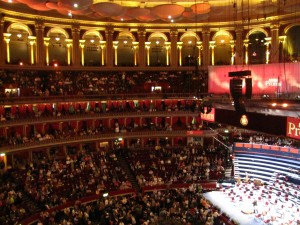
Royal Albert Hall
My following experience was Billy Elliot, which I have already blogged about, so I’ll try not to be redundant here. Other than being my first big West End experience, it was also important because it showed a lot of the themes of our course in a new light. Instead of applying the themes to the immigrant communities, it showed the themes in terms of a distinctively native English story. Furthermore, it also highlighted two differences between English and American theatre in particular. Firstly, we aren’t used to paying for our programs in the States. As an avid theatre goer, I’m used to being handed a Playbill (or regional equivalent) and continuing into the theatre. I don’t have to wonder who the cute guy playing a certain character is or why so and so looks so familiar. I don’t mind paying an extra three quid when I’m paying half of what I’m used to paying, but it definitely caught me off guard. Secondly, the tradition of stage door here is (as far as I’ve gathered) practically non-existent. In NYC, it is fairly common to wait after the show at the stage door to thank the actors for their performance, get an autograph, and if you are lucky, a photograph. (Yes, this can be a weird experience, but it can also be a great one.) When we went after Billy, it was completely different. While there were people there, the actors went by ignoring everyone. After Holly mentioned it, I realized that this was indeed a representation of the English concern for privacy and social dis-ease. On stage, the actors are free from interacting with the strangers feet away from them. At the door, they are in a different type of spotlight. Yet, the boundaries between personal and private life would not intersect. They are still technically at work. The guys from The Globe seemed to enjoy that we acknowledged them. I can’t wait to try another stage door experience to see the difference. (I planned to try again after Les Mis, but it was raining…)

The Victoria Palace, Home of Billy Elliot
Next came Bedlam, back at The Globe. For the first play by a woman performed there, the show was interesting. I’d like to say it succeeded it my expectations (which weren’t that high), but it didn’t. It did meet them, but something about the show was lacking the magic of the first show we saw there. At the end of the first act, I wasn’t at all satisfied, but by the end of the second, it had redeemed itself. I’d like to blame this all on not being a groundling and therefore surrounded by the audience members and the actors. I did enjoy it but it was not my favorite by any stretch.

The Globe, A View From Above
Lastly (thus far) is Les Miserables. One of my favorite musicals, I thoroughly enjoyed it. Despite the fact Marius has a slight bald patch, the actors were outstanding. (Even Norm Lewis, who I have seen in another musical and was THOROUGHLY disappointed in then, was outstanding. His awkward- but commanding- stage presence was perfect for Javert.) A truly equalizing musical, I was not surprised to see people in blue jeans and others in formal dresses. The difference is interesting when considered in the context of the musical and its equalizing themes. Theatre in London is truly for everyone- no matter one’s status. Seeing the opposites in dress at this show hit me as strangely appropriate. (I don’t want to elaborate knowing that some of you guys have yet to see it. So, I’ll just leave it at that.)
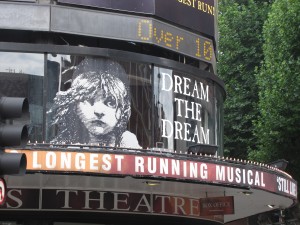
So far, I’ve thoroughly enjoyed my experiences at the theatre and can’t wait for more. I’m hoping to see Wicked (my favorite, in case you have missed that slight detail) and Blood Brothers at the very least. While technically not theatrical, I also expect my experiences at the various football matches I’m planning on going to to be worthy of a theatre stage!

Tags: 2010 Stephenie · Theatre
August 30th, 2010 · 1 Comment
Today I saw two very, very different sides of “Britishness,” one at the Notting Hill Carnival and the other at a West End performance of Billy Elliot. I was under the impression that the Notting Hill Carnival was supposed to celebrate the West Indian cultural heritage of the immigrants who came to the Notting Hill area in the 1960s and onward, but barr a lot of flags and glitter, I sort of missed the cultural celebration part. I got the celebration, definitely, but I was expecting much more emphasis on West Indian music, crafts, etc… Instead I heard a lot of American rap, dodged a lot of people drinking, and saw too many people wearing spandex and feathers who should really have rethought the spandex. Really, really rethought the spandex. Don’t get me wrong–the costumes in the parade were absolutely stunning, and the food was fantastic. It just seemed as if culture was put on the backburner so that drinking and partying could dominate the day. Kind of like Saint Patrick’s Day in America–a bunch of people dig up their Irish heritage (or fake their Irish heritage) in order to drink more for the day. Definitely very interesting to see, but kind of disappointing as a cultural learning experience.
Directly after leaving the carnival, however (which took some fancy navigating), I went into the West End to see Billy Elliot, which was so many types of amazing. As I was watching the show, I was struck by what a different type of cultural celebration it was–it concentrated exclusively on British working-class culture, particularly in Northern England. Stephenie, Matt, and I were talking during intermission about how much we could tie our readings into the show’s themes, and also about how we were really enjoying seeing a show that was so “British.” Lee Hall, who wrote the screenplay for the film with Jamie Bell and then adapted it to the stage, had a piece in the program in which he talked about how creating a show that was true to the working-class culture that he came from. We’ve concentrated a great deal on immigrant populations to England, which is definitely an important and dynamic topic, but we haven’t really addressed white British culture too much. Billy Elliot centers around the coal miners’ strike during the Thatcher era and, allowing for theatrical exaggeration, is a really interesting look into the lives of working-class families in that situation. Some of the themes presented in the play really resonate with our readings, as well. Billy, a twelve year-old boy, wants to break with the family tradition of coal mining by going to ballet school, so his family has to learn to cope with his aspirations. His older brother spends an entire scene talking about keeping the family together and how hard it is to uphold family values in the face of economic desparity and change, which somewhat mirrors the immigrant experience. It’s a different look at what was happening in England during the 1980s, and I found it really interesting. It opened up the picture of British identity a bit more. And the music and choreography were stunning. I think that I overused the word “fabulous” by quite a bit. Yes, it’s touristy, but it’s an amazing show and could also be used as an interesting counterpoint to our discussions of immigration. Just be prepared to be singing the songs for a few days afterward.
Tags: 2010 Holly · Theatre · Uncategorized
September 19th, 2009 · 1 Comment
Nights out in London have been proven to be interesting. Whether going out dancing in Metra, seeing a Shakespeare play at the Globe, grabbing a drink at a random pub, or walking through Thames River at night and enjoying a festival, London has a variety of entertainments for those looking to get out of their “residence” spaces aka the Arran House. The choice is behind a Londoner on what to do for “a night out.” For a typical night out in London, one can expect to pay a visit to at least one pub to grab a drink or two, to chat with “drunk locals who seem as much part of the building as the rafters that support the roof,” staying until the closing time and then heading back to the locations of “residence.” Although pubs have been the source of entertainment in England for centuries and one can not find anything similar in other parts of the world, I have not been particularly impressed by the pub culture in England, but that maybe also be because I rather dance the night away than sit around drinking Ale. Luckily, I was able to find several locations in trendy London where they play music that I, an American, recognized and I had great friends with me who are amazing dancers and are willing to “break it down” on any dance floor. In comparison to the American night life culture, it seems that the Brits are laid back, satisfied with socializing and more focused on chit-chating the night away. While experiencing the actual night life in London, I was more interested in “classical leisure.”
Always being a fan of plays, musicals, theater and anything involving a plot , I was that one individual who was excited before every show we were going to see during our time in London. Some were more disappointing than others (shall I say…Marilyn Monroe in Blood Brothers) while others brought on tears, laughter, compassion and love. With watching two Shakespeare plays, As You Like It and Troilus and Cressida in the actual Globe Theater, seeing the creativity behind the staging and lighting of All’s Well That Ends Well, and an interesting idea of Arcadia which compares two different families in two different centuries yet again there are ways in which their lives are interconnected. Being that this was the first time that I had ever seen Shakespeare plays, I want to focus on the characters presented by the writer in Troilus and Cressida,As You LIke It and All’s Well That Ends Well.
Although Shakespeare has written plots from dramatical pieces to comedy, his comedian side seems to always pay a visit. In all of the three Shakespearean plays that we have seen, we have had a character who one might say is not only entertaining but is also the representation of truth and class differences. In Troilus and Cressida a character by the name of Thersites can be described as “a deformed and scurrilous low class fool.” Although throughout the play, the plot of the story does not focus on him, he provides the audience a laugh as well as a different outlook on the war that is going on between the Trojans and the Greeks as well as on the love triangle that is continuos throughout the play. In Shakespeare’s As You Like It, there is a more obvious character who we know will serve the comedic role. A character Touchstone, whose first scene involves a joker costume was an instant hit and a constant laugh. Hands down he has been my favorite character in all of the plays we have seen.
Shakespeare’s focus on his characters and his plots show realistic situations of actual people. His emphasize on the interrelationship between characters, most of the times very complicated relationships, Shakespeare was able to focus on history, love, and passion and make his plays educational in every sense possible. I was also very surprised that the plays that we have viewed all had recurring themes of sexuality. It is clear that Shakespeare was ahead of his times. And of course, the theme of love did not escape me. Shakespeare’s ideas of unconditional love, jealousy, and desire were clearly displayed by the actors who were lucky to be performing on the stages of the National Theater as well as the Globe Theater (although it is not the original!).

I have greatly enjoyed the varieties of the performances we have seen in London over this past month. I can not express how grateful I am for everything that I was able to witness. These experiences will stay with me forever. Thank You everyone and Professor Qualls!
Tags: Jeyla · Pubs · Theatre
September 15th, 2009 · No Comments
-
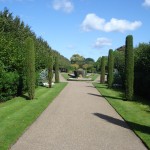
-
Regents Park
-
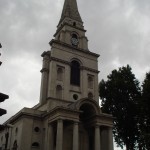
-
Christ’s Church
-
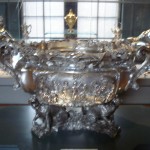
-
The Silver Exhibit in the V&A
-

-
Having a Good Time at the Fitzroy
Like many of my classmates I decided it would be worthwhile to summarize all of my discoveries this month in London. During this post I will focus on six main themes found within London: Parks, Churches, Pubs, Other Religious Institutions, Theatre and Museums.
Parks
Each park that I visited had its own distinct characteristics that separated it from any other. Green Park was the first I visited and after perusing a few others, I realized there was nothing that exciting about it. Located right across from Buckingham Palace, Green Park certainly provides a good place to go and take a break from the busy atmosphere of the area. Besides this however there is not much going on and I would recommend that potential park goers walk the extra distance over to St. James Park.
In addition to the large number of waterfowl heckling people for food which offers consistent entertainment St. James offers some picturesque flower beds throughout and various monuments along the way. It has the relaxing atmosphere of Green Park with a bit more excitement sprinkled in.
Regents Park offers a completely different feel from Green or St. James. Located in a separate area of London, Regents Park has a history of being used by a higher end crowd. I could tell this immediately from the feel of the park. The decorative shrubbery and elegant architecture throughout gave me a feeling that Regents is not as well used as other parks.
Since I was one of the members of the Parks group that gave a walking tour of Hyde Park and Kensington Gardens I could go into a lot more detail about these two green spaces but I will choose not to in an effort to be concise. In summary Hyde Park is the largest green space in London and is often used for larger events such as concerts, festivals etc. It also contains a large number of monuments throughout including the 7/7 memorial and the Diana Memorial Fountain. Kensington Gardens is home to a variety of key monuments but is not as well trodden as Hyde. Overall it makes for a quieter atmosphere, more conducive fo reading or “snogging”.
Regents Park were my two favorite green spaces in London. Regents, is both beautiful, and extremely large and I continually felt the need to go back and explore. Kensington Gardens appealed to me in that it was quainter than Hyde Park but contained a like amount of history and monuments throughout. Although I would be content spending a length of time in any London green space Regents and Kensington would be my top choices.
Theatre
Overall I enjoyed going to the theatre on so many occasions. What better place to do so than in London after all? Here I will discuss my favorite performances and theatre venues.
All in all I enjoyed all but two of the performances we saw. The two Shakespeare productions at The Globe Theatre were fantastic. Although I did not particularly enjoy reading Troilus and Cressida it made a huge difference to be there so close to the actors. The fantastic drum chorus at the end really sealed the deal. As You Like It was probably my favorite show I saw here in London. Although it is one of Shakespeare’s simpler plays the actors really made it jump off the page. Being down it the pit was fantastic because of all the ad-libbing and constant interaction with the crowd. I even felt traces of Touchstone’s saliva on my arm at one point.
The other Shakespeare performance I saw, All’s Well That Ends Well, was lackluster. Although the Olivier was my favorite performing venue (this is what an auditorium style theatre should be like…why can’t Dickinson have something like this?) the play itself was odd and ended on an abrupt and odd note.
The other play we saw at the National Theatre, The Pitmen Painters, was fantastic. Although I was dozing a bit because of the Benadryl I took right before the show, the actors kept my attention and I appreciated that the play was based off of a true story.
Easily the oddest play we saw was Arcadia. An extremely intelligent performance the play juxtaposed two different periods in time and created a singular storyline in which the plot was based. Overall it was an entertaining performance that made me think early and often.
Finally there was Blood Brothers. The lone musical I saw produced feelings of disbelief, anguish and held back laughter. The ridiculous 80’s sound track and creepy narrator just didn’t do it for me. I think it’s safe to say that I was not the only one from Humanities 309 who was a bit surprised to see just about everyone in the audience give it a standing ovation.
I had a very positive experience with the theatre here. I would go back to the globe again and again. I loved being that close to the action. I would also enjoy seeing another show in the Olivier. There really is so much to choose from here. It’s simply a matter of figuring out your tastes and saving your money so you can see a lot of performances.
Churches
From Westminster Abbey to St. Paul’s Cathedral we saw most of the major churches/cathedrals during our month in London. St. Paul’s was easily my favorite. From the fantastic crypt to the hundreds of stairs up to the tower it had so much to offer in the way of history and mystique. Westminster Abbey fascinated me primarily because of all the literary figures that had been buried inside as well as the room that was dedicated to “The Order of the Bath”. Other churches that I really enjoyed taking a look at were: “St. Martin in the Fields” which sits just outside Trafalgar Square and Nicholas Hawkesmoore’s “Christ’s Church” which is located in very close proximity to Brick Lane.
Other Religious Institutions
Overall the Sikh Gurdwara was my favorite place that we visited. I appreciated the simplicity of the religious doctrine as well as the conviction and honesty with which our tour guide, Mr. Singh spoke. The morning was capped off with a fantastic sit down meal together in which everyone was served the same food and drink.
I had different feelings about the Hindu Mandir. It was clear to me from the very beginning that the Hindu religion is not nearly as modest as Sikhism nor are they trying to be. From the extremely decorative prayer room, to the museum located right in the center of the Mandir I never felt particularly comfortable inside.
The only religious institution I wish we had gotten a chance to visit is a Mosque. I had been to one many years ago but I did not remember a whole lot from my experience. I wonder how much more lively the East End, and all parts of London would be if Ramadan were not taking place during our time here.
Museums
I could go on and on about museums so I will attempt to stay as concise as possible.
The British Museum was massive, convenient since it was so close to the Arran House but a little one dimensional at times. One of my favorite exhibits at the British Museum was a special exhibit on Living and Dying that drew information from all different time periods and cultures.
The National Gallery was fantastic. Although I have a hard time appreciating some visual art the gallery kept my attention for a number of hours. Seeing so many famous works of art was phenomenal.
The Tate Modern was my least favorite museum here. Although I am trying I have a hard time understanding modern art. After about 45 minutes in this museum it ended up being too much for me.
The Cabinet War Rooms/Churchill Museum were two of my favorites. The realization that I was standing in one of the most important places in World War II history was unbelievable. The War Rooms felt so authentic. I really felt as though I had been taken back in time to the 1940’s while inside.
The Victoria and Albert was easily my favorite museum in London. There was so much variety inside and so much to see. I could have easily spent a few days inside. Two of my favorite exhibits were the silver and jewelry exhibits. I’m not sure what this says about me as a person but I found it unbelievable that individuals could even own such treasures. I also enjoyed the laid back atmosphere of the V&A staff. At most of the other museums I visited I felt like I was doing them a disservice simply by being there. Although I understand that taking pictures of an object in a museum doesn’t do it justice I like to be able to have the option of doing so.
The Sir John Soane museum interested me but it wasn’t really my cup of tea in the end. It also had a stuffy atmosphere to it that I didn’t really appreciate.
One thing I can draw from my experience at museums here is that each and every one has something that distinguishes it. With so many museums I thought that it would be impossible to avoid some overlap but I never really felt that. Cheers to London and its museums.
Pubs
Finally we have pubs. What would London be without it’s public houses? In some cases pubs are the true museums of London, designating what an area was like in the past and what type of clientele it attracted. During my month here I had a chance to visit a few pubs and get a general sense of what some possible differences could be. It is clear to me that each pub brings something different and unique to the table. The Marlborough Arms was convenient being so close to the Arran House and was a great place to enjoy a pint over a meal with friends. The Court was conducive to socializing in a different way. The music was louder, the people louder and the drinks cheaper. Other places I visited offered other things that made them stand out as well. One thing that i’ve learned about pubs is that it’s hard for one to please everyone. Since everyone has different tastes and desires when it comes to pubs you are better off going to one with a small cohesive group.
To conclude this novel I would just like to say that I think we saw a lot of different faces of London this month. I realize there is much more to see here but between walking tours throughout the city, trips to major monuments and museums and individual exploration I have learned a ton about London, it’s history and where it is going. I look forward to more London explorations in the future but for now, ON TO NORWICH!
Tags: Churches and Cathedrals · Henry · Pubs · Theatre
September 14th, 2009 · 1 Comment
During our time in London we’ve had the opportunity to attend many theatre performances. As I chose to see the optional plays as well, the total count comes to 6: Troilus and Cressida, Arcadia, All’s Well That Ends Well, As You Like It, Pitmen Painters, and Blood Brothers. Although I could probably write an entire paper on each of the plays, I would actually like to discuss the three Shakespeare plays I saw, especially the differences in the theatres where they were performed: The National Theatre and Shakespeare’s Globe.
The first Shakespeare performance we saw was Troilus and Cressida. To be honest, I wasn’t all that excited about the story when I read the play over the summer as it was not as engaging as his more famous plays I was familiar with already. Therefore, I wasn’t too excited to stand for three hours through a play that I thought would be rather boring. The experience at the Globe was exactly opposite of what I was expecting, though. I loved being so close to the actors that I could see every minute facial expression. Seeing the live performance was also much more entertaining than reading it and I learned that you really must see a Shakespeare play to truly appreciate all of the subtleties that are often lost in the text.
All’s Well That Ends Well was performed in the Olivier Theatre of The National Theatre. The Olivier seats about 1200 people and is styled after a Greek amphitheatre. During our tour of the National Theatre, we learned that this semi-circular shape allows the actors to maintain a connection with the entirety of the audience. While this may be a better set-up than the raised stage in the front, especially for Shakespeare, one still has the experience of the lights going down and watching the events unfold from afar. I definitely did not feel a personal connection with the actors and at many points I could barely see their faces or expressions. Overall, I felt kind of far away and uninvolved. I found the play to be mediocre. It had some funny parts, but none were all that “laugh-out-loud.” I don’t necessarily think that this play was any worse than Shakespeare’s other plays as it is such a well-known title; I simply think I felt disengaged with the performance.
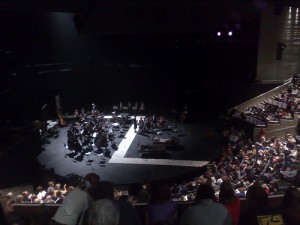
The Olivier
As You Like It proved to me my love for Shakespeare’s Globe. This performance was so incredibly interactive I enjoyed every second of it. At first, I regretted opting for the groundling ticket as I had just come from giving my walking tour, but I later came to realize it was the best place to be for the performance. During the play, the actors walked through the audience and even acted out the wrestling scene in the front of the groundling section. There were numerous points during the show when the actors made side comments about the audience that could not be heard from the seats farther away.
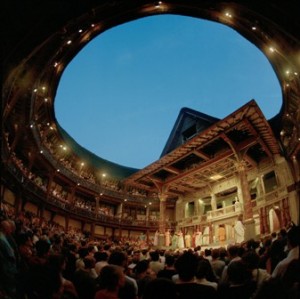
The Globe
The style of the stage at the Globe is the way Shakespeare intended his works to be performed. We’ve heard some criticism about the Globe, especially from A.N. Wilson, because of its links to Disney, its appeal to tourists, etc., etc. I don’t necessarily disagree with such observations, but I do think the Globe deserves some justification. There are few venues where one can see Shakespeare’s plays performed in this manner, and frankly I feel this is the best way to see these performances.
Tags: Sarah · Theatre
September 14th, 2009 · 1 Comment
Overall, I have really enjoyed being able to go to the theatre and compare the different productions that we have seen. But now that we have seen our last performance, I feel prepared and capable to tie in the themes that these productions present into a few of the overarching themes that we have experienced on the walking tours, class discussions, and readings. For time’s sake and space, I mostly would like to focus on The Pitman Painters and Blood Brothers in this particular post. The Pitmen Painters was undoubtedly one of the best straight-play performances that I have ever seen. The depth and layering of the dialogue really portrayed the time period in a realistic, yet humorous way.
This draws me to my next point: the playwright brilliantly conveyed the realistic themes of class struggles and economic differences while still managing to couple the drama with a relatable sense of humor. I felt that this performance creatively discussed the struggle and tension of the time. All of the men enjoyed painting, especially Oliver, and this simple act of painting morphed into a larger, more important symbol: a symbol of unfulfilled desire, and of the vain hope for a better future. As simple and unimportant as painting may seem to us now, it became an unmistakable symbol of class division throughout the play. For example, as much as Oliver wanted to paint, to leave the mines, and be paid for doing something that he loved, he was unable to liberate himself from the burdens of his class position. This internal and external struggle was highlighted by his benefactor, a woman of wealth who desired to collect his paintings. This brings up another distinction: while Oliver would be working tirelessly at painting, this wealthy woman would simply pay a small sum of money to collect his work and though he would leave the mines, Oliver would still be under the rule of another person. I think Oliver recognized that his paintings wouldn’t change his circumstance and in his mind he believed an escape from the mining world would be futile.
As a member of the audience, I can attest for the fact that I was hoping he would leave the mines, work as a painter, and become famous and wealthy enough to bring his friends out of the mines and support them until they were old men. But this vain hope makes the ending even more jarring and eye-opening. We all hope that Oliver’s life will work out happily ever after, but in reality he was a slave to the constraints and prejudices of his class—much like the immigrants in London are still laboring under today. As a group we have traveled to market after market and it is here that I have noticed a vicious cycle. Certain people are always “the outsider” the “laborers” and it is generally frowned upon for anyone to try and move up the ladder, so to speak. Reaching way back to the beginning of our stay in London, we discussed Great Expectations. This same theme occurs in Pip’s life. People are to stay within their class and not deviate from the norm or else pain and struggle will befall them. Better to remain in one’s class with one’s struggles than to risk the climb to the top- to achieve more.
Overall, the Pitmen Painters offered me a visual and emotional insight into the plight of the lower class. I thoroughly enjoyed this play, and though it was essentially a work of art, a fiction, it was based on the lives of actual people.
Now the Blood Brothers on the other hand, lacked the heavy reality and depth that the Pitmen Painters possessed. Though I generally love musical theatre, this particular performance struck me as vapid…though I did notice a similar theme of class division. I don’t really feel the need to go into detail here simply because there was no real depth to the performance other than the fact that one brother struggled throughout his life and the other didn’t because of his wealth.
Though the musical was extremely dramatic, it actually lost its sense of any authenticity that may have saved it from becoming complete crap. Now although I am railing on this, it also echoed the Pitmen Painters by emphasizing that class and wealth have a profound effect on the outcome of one’s life. These two plays, though both very different, have really helped me to connect and visualize the theme of class and economic struggle through both thought-provoking dialogue (mostly in Pitmen Painters).
Tags: Maddie · Theatre
September 14th, 2009 · No Comments
Although I have blogged, to some extent, about most academic things I have done in London, I feel that I have a better impression of most things now than I did at the beginning of the stay. Along this vein, I feel the need to revise, or just plain state, my opinions on the “Big Five” topics – parks, churches, museums, theatres, and pubs.
I have now been to five of the Royal Parks in London. Green Park, Kensington Gardens, Hyde Park, Regent’s Park, and St James’ Park are all very similar and yet very different in their own ways. I found Green Park, situated very close to Buckingham Palace, to have the most unfriendly atmosphere of the five. There is very little to Green Park. There are trees, benches, grass, the ever-popular lawn chairs for rent, and beautiful ornate gates facing Buckingham Palace. I think the reason I found the park so cold is that it was, well, too green. There were no flowers or water features (except for one fountain commemorating the Canadians), just trees, grass, and benches.
This is vastly different from the other four parks I visited. St James’ Park, Hyde Park, Regent’s Park, and Kensington Gardens all were beautifully landscaped with brightly colored flowers, clean fountains, scultpures, and natural or constructed water features. In Hyde Park, Regent’s Park, and Kensington Gardens it was easy to forget that you were in the middle of a pollution-filled city. As I am not much of a city person, it was extremely refreshing for me to not be able to hear or see traffic for a while. With Green Park and St James’ Park, I couldn’t shake that feeling. However, I am a firm believer that parks, whether or not they are within city limits, always make people feel healthier. For this reason and the sheer beauty that the parks portrayed in their different ways, I understand why I did not only see tourists, but the people of London as well.
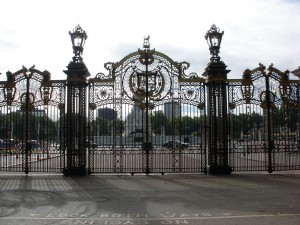
Gates towards Buckingham Palace from Green Park
Churches and other places of worship are an integral part of societies throughout the world. Throughout our time in London, we have been fortunate enough to visit Westminster Abbey, St Paul’s Cathedral, a Sikh gurdwara, and a Hindu temple. Of these four I enjoyed St Paul’s Cathedral the most from a purely historical standpoint and the Hindu temple most from a cultural perspective. St. Paul’s is one of the most recognizable and interesting buildings in London. It not only houses some of the most important military remains in the country (the Duke of Wellington and Admiral Nelson), but it was one of the most iconic images of WWII Britain. I also found it to be less like a museum where I felt like hop-scotching around graves in the floor (Westminster Abbey) and much more like a place of worship.
I enjoyed the Hindu temple for very different reasons. Although there was a definite sense of it being a tourist attraction, with the gift shop in the lobby and the interpretive centre with tiny models of Hindu gods, the temple was still very obviously, well, a temple. Before going there, I had no idea what Hinduism was like. I knew that there are multiple gods and that one is an elephant, but I didn’t know about their dedication to peace and volunteer work. What really struck me about it was that the intricate carving and craftsmanship of the facility was all done by volunteers. I think that this cultural experience was only heightened by being able to observe a service in the sanctuary that was so unlike my own Roman Catholic faith.
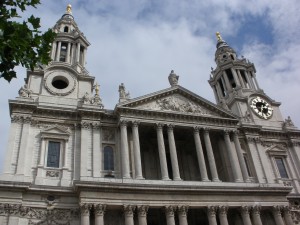
St Paul's Cathedral - a symbol and a place of worship
I had very mixed experiences with museums in London. Some, like the Victoria and Albert, I just didn’t seem to understand in the amount of time I spent there. However, I think that if I went back and dedicated a day to the facility, I would appreciate how the seemingly-random exhibits link together much better. (I did enjoy the items on display in the V&A, I just had an issue with the layout of the museum.) Other museums, like the Museum of London and the Docklands Museum, were put together in a very fluid and informative manner that I enjoyed greatly. My two biggest museum issues were with the British Museum and Sir John Soane’s Home/Museum. Grace and I wrote extensively on our thoughts on the British Museum, so instead of repeating everything, I’ll just give a brief summary: why are all of these amazing artifacts that have no connection to Britain in the British Museum?
The Sir John Soane Museum is a completely different story. I appreciated that the museum was free and displayed an extremely eclectic collection, but please never make me go back there ever again! It was the single most claustrophobic place I have ever been in my entire life with possibly one exception. Call it a personal thing, I do not like it when random pieces of monuments are mounted on the ceiling directly above my head. I am also not a big fan of walking into a room in a house and having literally hundreds of sculpture eyes staring at me from every surface around me. I disliked it so much that I could not even finish going through it, and anyone who has been in a museum with me will know that I read and see as much as I possibly can. I don’t understand why that creepy building perfectly-suited to be a haunted house at Halloween is called a museum. (Please if you can attempt to explain it to me, go right ahead!)
Theatre is a subject I have talked about in a couple of different posts (Observations on Accessibility and Blood Painters and Pitmen Brothers), however, I have not discussed theatre in general. I was lucky enough to see Troilus and Cressida, All’s Well That Ends Well, Arcadia, The Pitmen Painters, and Blood Brothers. Each of these theatre experiences were extremely different, but all valuable in their own ways. Troilus and Cressidawas shown in the Globe Theatre and we had groundling tickets that forced us to stand for the 3 hour performance. The actual standing wasn’t nearly as bad as I thought it would be, but the best thing about the show was being quite literally three-to-four feet away from the actors on stage. (Actually, it was slightly amusing when Hector died and was lying 3 feet away in our line of sight for the last 20 minutes of the play!) The staging of this Shakespearian play was vastly different to All’s Well That Ends Well, which was put on in the National Theatre. In the Globe, the sets are quite minimal because they have to perform four or five different shows on the same stage in the space of a few days. The set for All’s Well That Ends Well was much more elaborate and specialized for the show. Rather than the reliance on the actors and the costumes that the Globe used to tell you where the play was occurring, All’s Well That Ends Well used a dark set with elaborate staircases to add to the mood of characters and the dialogue.
Much like with Troilus and Cressida, the set for Arcadia was also pretty simple. Although the play took place in two different years, it was set in exactly the same room with almost all of the same props. This was a very effective way to stage the show and allowed for the writer, Tom Stoppard, to do some very interesting things with the characters from both time periods, like when he had them all in the room at the same time, oblivious to each other. I particularly enjoyed the way that this play was set and how basic it was. It was vastly different from the more complicated sets of The Pitmen Painters, which included projection screens, and Blood Brothers, which had lots of windows for the Devil/God character to peer creepily out of.
This final subject I have not blogged about at all. Pubs are an integral part of British culture. That said, pubs are also an integral part of Irish culture, so I experienced pub life when I lived in Ireland. British pubs and Irish pubs have a lot of similarities and differences. In both places, you must push viciously up to the bar in order to get your food and drink, you have to be 18 to have alcohol, smoking must be done outside, and there are usually way too many people in the pub for you to feel comfortable. Oh, and you always pay way more than you think you should for your drink. I’ve been to a couple of pubs in London and have found that they are all fairly similar. The bartenders are nice, but kind of frantic; the food is good, and usually relatively cheap; and the music is God-awful 1980s or techno playing at volumes that are way too loud. The first two are cohesive with pretty well every Irish pub I’ve ever been in, the third is not. Irish pubs play good music… or at least much better music than I’ve heard here! There are a lot of pubs that have a band playing traditional Irish music in front of you in the pub for pints and there are also a lot that play modern music at volumes that make my ears want to cry – but at least the music isn’t a Cher and Meatloaf duet accompanied with the weirdest music video I have ever seen in my entire life. (This particular musical masterpiece was played in The Court the other day. I never would have thought of that particular combination, but oooooookkkkkkkkkk.) Truth be told, I just want to find a comfortable pub with some good music and that will make me just as happy as George Orwell’s fictitious Moon Under Water.
Tags: Churches and Cathedrals · Kelley · Museums · Pubs · Theatre















